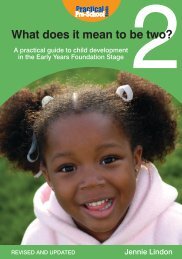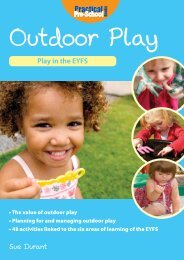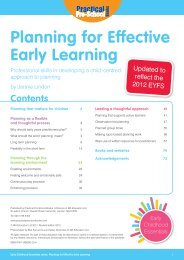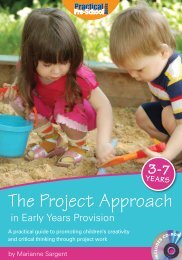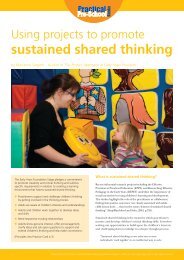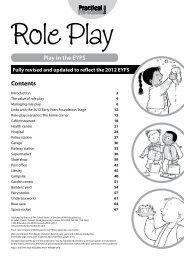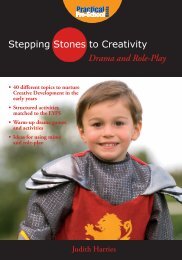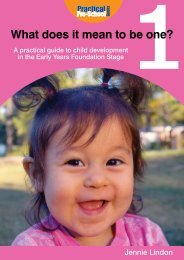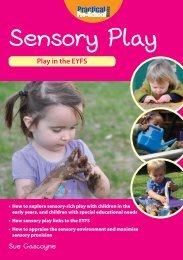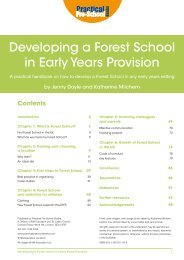Heuristic Play Book.indd - Practical Pre-School Books
Heuristic Play Book.indd - Practical Pre-School Books
Heuristic Play Book.indd - Practical Pre-School Books
Create successful ePaper yourself
Turn your PDF publications into a flip-book with our unique Google optimized e-Paper software.
<strong>Book</strong>s<strong>Heuristic</strong> <strong>Play</strong><strong>Play</strong> in the EYFS• Activities for all age ranges in the early years• Observation and assessment suggestions• Links to the EYFS, schemas and child developmentSheila Riddall-Leech
<strong>Book</strong>s<strong>Heuristic</strong> <strong>Play</strong><strong>Play</strong> in the EYFSContentsWhat is heuristic play? 2The role of the adult 4The theory of heuristic play 5General links to the EYFS and schemas 7<strong>Heuristic</strong> play for non-mobile babies 11<strong>Heuristic</strong> play for mobile babies and toddlers 21<strong>Heuristic</strong> play for young children 22 to 36 months 32<strong>Heuristic</strong> play for young children 36 to 60 months 39Observation templates 46Glossary of terms 50Further references 51Published by <strong>Practical</strong> <strong>Pre</strong>-<strong>School</strong> <strong>Book</strong>s , A Division of MA Education Ltd,St Jude’s Church, Dulwich Road, Herne Hill, London, SE24 0PB Tel 020 7738 5454© MA Education Ltd 2009wwww.practicalpreschoolbooks.comAll rights reserved. No part of this publication may be reproduced, stored in a retrieval system, or transmittedby any means, electronic, mechanical, photocopied or otherwise, without the prior permission of the publisher.The author reserves the right to be identified as the author of this work.<strong>Play</strong> in the EYFS: <strong>Heuristic</strong> <strong>Play</strong> ISBN: 978-1-90457-592-4
What is <strong>Heuristic</strong> <strong>Play</strong>?Think about itThink about your own learning experiences at school.What learning can you remember that was reallyeffective and why do you think this was? Can you thinkof any learning experiences that you had that were notsuccessful for you and can you think why this mightbe? For example, someone can tell you how to drive acar, and you can read up on the subject and look on theinternet, but unless you actually get behind the wheelof a car and drive, you will not be successful. Learning todrive requires first hand experiences.<strong>Play</strong> can and does, take many forms. It changes as we growand develop. In the first instance play enables us to learnabout things and objects in our environment, then laterthrough play, we learn about people, thirdly play makesit possible for us to learn about ourselves. Whether playis alone or in groups, messy, noisy and energetic or quiet,all children benefit from it. <strong>Play</strong> can be a solitary or socialexperience, we can be fully involved or just watch andobserve, but whatever form it takes it is of immense valueand fundamental to learning.It is widely accepted that play is the primary way thatbabies and young children develop and learn. Learningis about being able to do something by oneself, such asreaching out and grasping an object, writing your name,understanding the difference between hard and soft,fastening a button. This is often referred to as ‘learningthrough first-hand experiences’. When babies and childrenlearn through play they feel free to experiment, are incontrol of their own learning and find ways of managingsituations, both real and imaginary. Learning through playis fundamental to all areas of a child’s development.<strong>Heuristic</strong> play is a very simple approach to helping babiesand young children learn. The approach uses natural andhousehold objects presented to babies and children so thatthey can experiment and discover independently. The term‘heuristic play’ is often confused with ‘holistic play’ but thetwo terms are quite different. Holistic play is when you planfor and meet the needs of the whole child; as in holistictherapies which aim to treat the whole person rather thanjust the symptoms. For example taking an aspirin maytemporarily cure a stress headache, but a holistic treatmentwould treat the cause, that is to say deal with the stress. Theword ‘heuristic’ originates from the Greek ‘eurisko’ whichmeans ‘I discover’ or ‘I find’. You may recall the ancientstory of Archimedes who leapt out of his bath shouting‘Eureka’ as he discovered that his body caused the waterlevel to rise. ‘Eureka’ simply means ‘I have discovered’, or ‘Iunderstand’.<strong>Heuristic</strong> play is an approach for practitioners to follow. It isnot a prescription or instruction, in short it is unrestrictedand totally child-led. <strong>Heuristic</strong> play uses natural, recycledhousehold objects that can be found in the home andin the environment. Babies and young children who areengaged in heuristic play explore, find out, investigate anddiscover for themselves, without active adult intervention.<strong>Heuristic</strong> play allows babies and young children to make2 <strong>Heuristic</strong> <strong>Play</strong>
choices and develop preferences and experience playopportunities that are both spontaneous and focussed.The guidance for the Early Years Foundation Stage tells usthat ‘when children have opportunities to play with ideas indifferent situations with a variety of resources, they discoverconnections and come to new and better understandingsand ways of doing things’ (Principles Into Practice Card 4.3-Creativity and Critical Thinking). <strong>Heuristic</strong> play is one suchvery effective play opportunity if planned and resourcedappropriately.Some people also think that heuristic play and treasurebaskets are the same thing, when in fact treasure basketsare only one aspect of heuristic play. Treasure basketsamongst other aspects will be discussed in more detail inthe next chapter.<strong>Heuristic</strong> play is open-ended, items and objects can beused and played with in any imaginative way that thechild chooses and so there is no ‘wrong’ or ‘right’ way toplay. <strong>Heuristic</strong> play can be totally individual as babies andyoung children react and respond in their own unique anddistinctive ways. Children with special needs can engagesuccessfully in heuristic play as it stimulates their sensesand is open-ended, rather than prescriptive. What it is not isan opportunity for the adult to sit back and let the childrenget on with it. As with any play opportunity it needs carefulplanning, consideration of health and safety issues andappropriate resources.Think about itIn a way heuristic play continues throughout our livesas we discover and make sense of new things in ourphysical world. What do you do when faced with avegetable or a fruit that you have not seen or eventasted before? You probably touch it with your fingers,turn it over in your hands and feel its texture, yousmell it, maybe shake it and listen if it rattles or makesanother noise, and you look at it carefully and perhapstaste it. Isn’t this heuristic play? It is learning about thefruit from your own first-hand experiences. In fact, anyform of scientific enquiry could be described simply asheuristic play.<strong>Heuristic</strong> <strong>Play</strong> 3
<strong>Heuristic</strong> play for mobile babies and toddlers(Approx.) 9 to 22 monthsWhat do they need?As soon as babies begin to make independent attemptsto move and crawl the world becomes a very differentplace. Crawling is not just a physical activity; the brainand therefore cognitive development, is also stimulated.New possibilities present themselves; the baby can notonly move themselves about, but can also move objectsfrom one place to another. They can see the world froma different perspective and can begin to develop spatialawareness. Their explorations and investigations willrequire more space, and this will have implications foradults’ planning and resourcing.Obviously the point at which a baby begins to move aboutdepends on their own individual rate of development. Notall babies go through a crawling on all fours stage, someshuffle, and some may have a very short period of crawlingbefore they attempt to walk. You will need to use your ownprofessional judgements based on observations as to whenyou need to offer more than a treasure basket.A treasure basket can still be offered to a toddler in this agegroup; perhaps when a child is feeling tired or not particularlywell they will often benefit from playing with somethingfamiliar. At times such as these, all children need thereassurance of a sensitive and caring adult and so the treasurebasket can be a source of comfort, especially if it is used on aone-to-one basis. In these circumstances you could talk to thetoddler about the objects and interact more than you wouldnormally do if the basket was being offered to a baby.Sometimes early years practitioners can find it a challengeto plan appropriate activities and experiences for this agegroup. Many toddlers have become disinterested in ‘babytoys’, but are not yet mature enough to be involved inactivities planned for older children. The second year of ababy’s life is one of extraordinary growth and development;but Elinor Goldschmied believed that sometimes theexperiences and activities offered at this time, especially ingroup care, can be limiting. This is where heuristic play canreally be very beneficial.<strong>Heuristic</strong> play for this age group requires collections ofrecycled and household objects, a variety of sizes, shapes,textures and materials. In this way the toddler will stillcontinue to explore and investigate through their sensoryexperiences but will also be able to extend their learning.This form of play is quite active compared to treasurebasket play, but with the same purpose and concentration.In the first instance you can offer the treasure baskettogether with some large tins, boxes or similar containers.You will find that the baby will independently discover thatthey can drop things into the containers. If you watch thebaby, they will probably tip them out again and so discoverthe concept of ‘in and out’ and ‘here and there’; schemas ofpositioning, enveloping and cause and effect.As with the treasure basket there is no place for plastic toys.Most plastic toys offer very limited sensory experiences andalso will frequently have a single or correct way of playingwith them. For example, a plastic shape sorter will onlyhave one place where each shape can be posted. Whatoften happens is that the toddler will transport the shapeto a different place and post it somewhere that an adultmay consider inappropriate or ‘wrong’ and then the wholetoy could become uninteresting to the child.With heuristic play there is no right or wrong; there is nosense of failure. The toddler is able to experiment andCase StudyLucy, aged 15 months, took a little while to beginto explore the heuristic play materials and returnedseveral times to the adult nearby for support. Shediscovered that she could pile several different objectson top of each other; she used different sized tins,plant pots and plastic bottles. She squealed in delightas the pile of objects fell over, but immediately startedrebuilding her pile.<strong>Heuristic</strong> <strong>Play</strong> 21
investigate freely as to what they can do with the objects.They will learn and discover different outcomes to theirexperiments, for example a cork may fit into a plasticbottle, but may not come out very easily, whereas thesame cork can be put inside a tin and taken out againwith little effort. These different outcomes will stimulatethe toddler’s thinking and so help them develop a greaterunderstanding of the objects and their characteristics.In a heuristic play session a toddler needs to be able to dothe following:• Move or transport objects from one place to another ina variety of ways.• Put objects inside other containers and take them outagain, including smaller objects inside bigger ones.• Roll objects across the floor or over different surfaces• Bang objects together, sometimes connecting,sometimes not.• Make piles of objects and then knock them over,sometimes similar objects sometimes just randomchoices.• Make collections of similar objects.• Turn and twist objects either inside each other or intheir hands.• Wrap objects up in materials, including putting thingsover themselves.Not only can all of the above berecognised as schemas asdiscussed earlier in the book,or learning tools, the basisof problem solving canbe identified as well. Forexample, when a toddlerbangs two or more objectstogether, they will initiallyuse one hand. This laterdevelops into a twohandedaction whichis often rhythmic andinvolves large bodyCase StudyLucy and Oliver explored the heuristic play materials atthe same time. Lucy, the younger toddler, watched Oliverintently and copied some of his actions. She picked upa tube copying Oliver and made noises down the tubeas he had done. She watched as he put plant pots on hishead and tried to copy him. Although very aware of eachother, neither toddler made any attempt to play together.movements. This will eventually lead to the use of tools,and later to writing and drawing.As with a treasure basket, heuristic play does not depend onadult intervention and can be a solitary activity. Toddlers willplay and explore independently but at the same time willprobably be aware of the actions of others. They may play andexplore in parallel. They may well copy each other’s actions,such as banging two objects together and may laugh at thenoise they are making, but will not play together.Levels of concentration, because of the wealth of experiencesand opportunities for exploration are vast, are usually high.This is often regarded as unusual as toddlers of this age areeasily distracted. Children with special or additional needsmay also lack the ability to concentrate and can be easilysidetracked or have their attention diverted. <strong>Heuristic</strong> playfor these children can be especially valuable and meaningfulas the very act of exploring the range of materials can beabsorbing and so promote concentration skills.During heuristic play sessions the baby and toddler willmove through various stages:• The first stage is: what is this object? What is it like?At the stage the treasure basket can meet this levelof enquiry as the baby touches, feels, smells, mouthsobjects. This stage will also occur in a heuristic playsession, especially if new materials are offered.22 <strong>Heuristic</strong> <strong>Play</strong>
• During the second stage the baby has a good idea ofthe characteristics of the objects and materials and sobegins to consider what they can do with the objects.This could for example involve a toddler putting a tubeto their mouth and making noises, putting smallerobjects into a big tin and shaking it, putting corks ina bottle etc.• Finally, as language begins to develop a toddler willengage in what Piaget called ‘symbolic play’ as theybecome, interested in what an object could become.This could be a length of chain becoming a necklace,or chains in a tin becoming a drink. (Both evident in theDVD <strong>Heuristic</strong> <strong>Play</strong> with Objects (1992 NCB).What do you need to collect?Before you begin to make your collection you will have todecide how and where you will store the objects. For manysettings storage is an issue and 15 large tins can be quitea challenge to store safely. In the DVD <strong>Heuristic</strong> <strong>Play</strong> withObjects you will see that the adults have several large, fabricdrawstring bags in which collections of objects are stored.These bags are then hung on hooks, which keeps themclean and dust free. Large tins and containers are stored onshelves. When I began my collection, I made several fabricbags and stored items in them. I did not have room foranother shelf in the storage area and so bought some largestacking plastic boxes with lids. We, or rather the toddlers,put all the containers inside each other to save spaceand we put everything,including the drawstringbags, in the boxes whichcould then be stackedon top of each other andso save space.Not really ideal, buta solution to our storageproblem. The toddlerscould still be involvedin clearing away theobjects and materialsand the drawstringbags kept eachcollection separate.You will need to collect about 50 of thesame type of object and about 15 different collections,for a group of 5 or 6 toddlers to play at the same time;that means 50 wooden pegs, 50 shells, 50 containers ofdifferent sizes and material and so on. Elinor Goldschmiedsuggested that three large tins for each toddler wasprobably sufficient. (Ref DVD <strong>Heuristic</strong> <strong>Play</strong> with Objects)Think about itIf you have toddlers in your setting observe themduring a non-heuristic play session. Make a note of howlong they play with the toys provided, or how manydifferent toys that access in say, 45 minutes. Then set upa heuristic play session and compare the concentrationlevels of the toddlers.<strong>Heuristic</strong> <strong>Play</strong> 23




